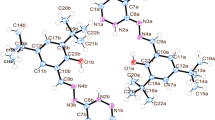Abstract
Metal complexes of Co(II), Ni(II), Cu(II), and Zn(II) with ligands (L1H and L2) derived from 4-aminoantipyrine, 2-hydroxy-3-formylquinoline, and isatin were synthesized and characterized by the elemental analysis, conductance measurements, magnetic susceptibility, and spectral analysis. The spectral data revealed that the ligands acted as a neutral tridentate, coordinating to the metal ion through the azomethine nitrogen, phenolic oxygen, and carbonyl oxygen of the 4-aminoantipyrine, 2-hydroxy-3-formylquinoline, and isatin molecule in ligands L1H and L2 only. Both the ligands and their metal complexes were studied for cyclic voltammetry studies. The ligand and the metal complexes were screened for their anticonvulsant activity, and it has been observed that the metal complexes are more potent than the ligands.



Similar content being viewed by others
References
Al-Soud YA, Al-Masoudi NA, Ferwanah Ael R (2003) Synthesis and properties of new substituted 1,2,4-triazoles: potential antitumor agents. Bioorg Med Chem 11:1701
Choi YK, Chjo KH, Park SM, Doddapaneni N (1995) Oxygen reduction at Co(II)2-disalophen modified carbon electrodes. J Electrochem Soc 142:4107
Geary WJ (1971) The use of conductivity measurements in organic solvents for the characterisation of coordination compounds. Coord Chem Rev 7:81
Guofa L, Chowngwu N, Bin L, Kunyuan M (1990) Complexes of lanthanide nitrates with a Schiff base derived from o-vanillin and p-toluidine. Polyhedron 9:2019
Katia B, Simon L, Anne R, Gerard C, Francoise D, Bernard M (1996) Synthesis and characterization of chiral Schiff base complexes with diiminobinapthyl or diiminocyclohexyl moieties as potential enantioselective epoxidation catalysts. Inorg Chem 35:387
Kulkarni SK (1981) Actions of clonidine on convulsions and behavior. Arch Int Pharmacodyn 252:124
Leppik IE (1994) Antiepileptic drugs in development: prospects for the near future. Epilepsia 35:29
Loscher W (1998) New visions in the pharmacology of anticonvulsion. Eur J Pharmacol 1:342
Meth-Cohn O, Narine B (1978) A versatile new synthesis of quinolines, thienopyridines and related fused pyridines. Tetrahedron Lett 19:2045–2048
Punniyamurthy T, Kalra SJS, Iqbal J (1995) Cobalt(II) catalyzed biomimetic oxidation of hydrocarbons in the presence of dioxygen and 2-methylpropanal. Tetrahedron Lett 36:8497
Sengupta AK, Gupta AA (1982) Synthesis of some 4-(1,5-disubstituted-2-oxoindolinyldeneimino)-2,3-dimethyl-1-phenyl-∆3-pyrazoline-5-ones as possible pesticides. Ind J Chem 21B:72
Thompson KH, Orvig C (2006) Metal complexes in medicinal chemistry: new vistas and challenges in drug design. J Chem Soc Dalton Trans 6:761
Timerbaev AR, Hartinger CG, Aleksenko SS, Keppler BK (2006) Interactions of antitumor metallodrugs with serum proteins: Advances in characterization using modern analytical methodology. Chem Rev 106:2224
Acknowledgments
The authors thank the Department of Chemistry and USIC, the Karnatak University, Dharwad for providing research and spectral facilities. Facilities provided for recordings of FAB mass spectra (by the CDRI, Lucknow) and EPR spectra (by the IIT Bombay) are gratefully acknowledged. Further, the authors thank the UGC and the Karnatak University for providing research fellowships.
Author information
Authors and Affiliations
Corresponding author
Rights and permissions
About this article
Cite this article
Kurdekar, G.S., Sathisha, M.P., Budagumpi, S. et al. 4-Aminoantipyrine-based Schiff-base transition metal complexes as potent anticonvulsant agents. Med Chem Res 21, 2273–2279 (2012). https://doi.org/10.1007/s00044-011-9749-3
Received:
Accepted:
Published:
Issue Date:
DOI: https://doi.org/10.1007/s00044-011-9749-3




